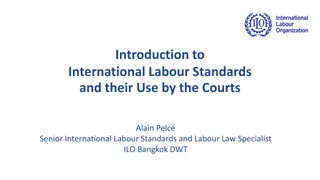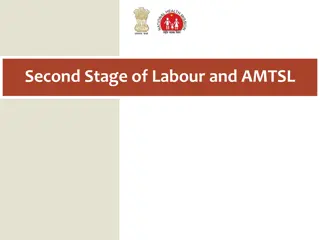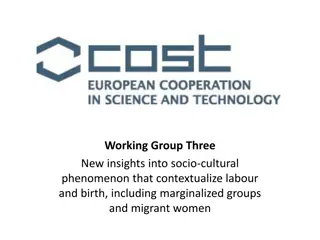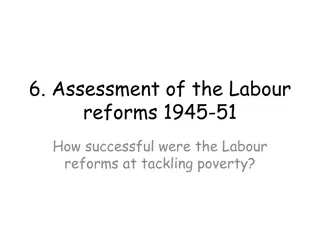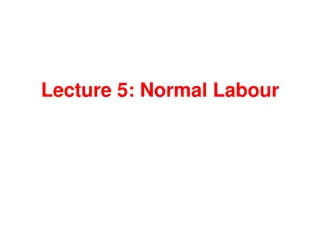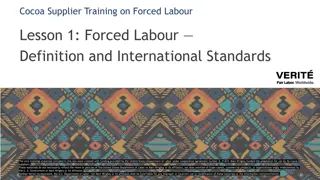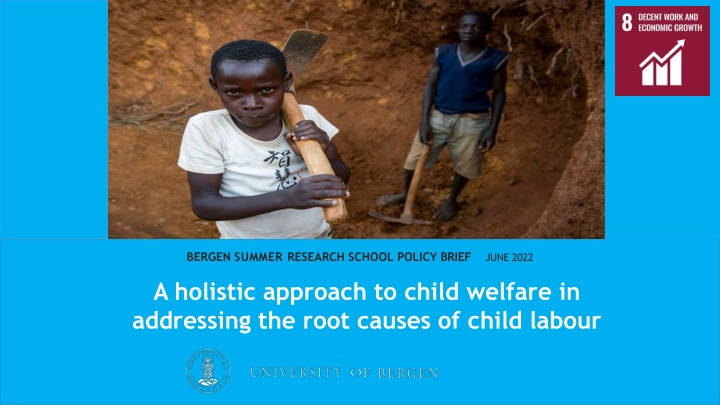
Addressing Root Causes of Child Labour Through a Holistic Approach
"Explore the urgent need for a holistic approach to child welfare in tackling the root causes of child labour, emphasizing social interventions, education, and economic improvements. Discover the global impact, especially in Sub-Saharan Africa, and the interconnectedness with SDGs. Learn why addressing child labour is crucial for sustainable development goals."
Download Presentation

Please find below an Image/Link to download the presentation.
The content on the website is provided AS IS for your information and personal use only. It may not be sold, licensed, or shared on other websites without obtaining consent from the author. If you encounter any issues during the download, it is possible that the publisher has removed the file from their server.
You are allowed to download the files provided on this website for personal or commercial use, subject to the condition that they are used lawfully. All files are the property of their respective owners.
The content on the website is provided AS IS for your information and personal use only. It may not be sold, licensed, or shared on other websites without obtaining consent from the author.
E N D
Presentation Transcript
BERGEN SUMMER RESEARCH SCHOOL POLICY BRIEF JUNE 2022 A holistic approach to child welfare in addressing the root causes of child labour
A holistic approach to child welfare in addressing the root causes of child labour With the increasing rate of child labour in Sub-Saharan Africa, we need to take a holistic approach to child welfare in addressing root causes of child labour. With effective social interventions, quality education and improvement in household incomes, we can achieve SDG target 8.7 Sustainable Development Goal 8.7 seeks to take immediate and effective measures to eradicate forced labour, end modern slavery and human trafficking, secure the prohibition and elimination of the worst forms of child labour and by 2025, end child labour in all its forms. Taking a holistic approach to achieve this goal will further lead to achievement of other SDGs such as SDG 1 NoPoverty , SDG 4 QualityEducation and SDG 10 ReducedInequalities Key points Around the world, growing economic inequalities in recent decades have forced millions of young children out of school and into work. Nearly 1 in 10 children are subjected to child labour worldwide while global progress against child labour has stagnated since 2016 Across regions, Sub-Saharan Africa is hard hit with a growing rate of child labour where the percentage of children aged 5 to 17 years in child labour in the region increased from 21.4% in 2012 to 23.9% in 2020. The largest share of child labour takes place within families, if they consider it as necessary to put their children to work in order to survive. Figure 1: Prevalence of child labour in different regions around the world in 2020. Source: ILO/UNICEF 2021 Child labour is frequently associated with children being out of school.
A holistic approach to child welfare in addressing the root causes of child labour Introduction Analysis Child labour is work that harms children or keeps them from attending school. Child labour refers to the employment of children in any work that deprives them of their childhood, interferes with their ability to attend regular school, and that is mentally, physically, socially or morally dangerous and harmful. According to ILO/UNICEF (2021), involvement in child labour is higher for boys than girls at all ages. Child labour is also more common in rural areas. For boy and girls alike, most child labour continue to occur in agriculture. Recent data indicates a growing rate of child labour in Sub-Saharan Africa. The percentage of children aged 5 to 17 years in child labour in Sub-Saharan Africa increased from 21.4% in 2012 to 23.9% in 2020. Between 2017 and 2021 alone, 16.6 million children on the continent have been forced into child labour due to population growth, extreme poverty and inadequate social protection interventions. Around the world, growing gaps between rich and poor in recent decades have forced millions of young children out of school and into work. The challenge of ending child labour is still quite arduous. According to the International Labour Organization and UNICEF, a total of 160 million children 63 million girls and 97 million boys are in child labour globally, accounting for almost one in ten of all children worldwide. (ILO/UNICEF, 2021) Child labour violates human rights, and is in contravention of the International Labour Organization (Article 32, Convention Rights of the Child). About one- third of children of the developing world fail to complete at least 4 years of education (UNICEF, 2006). Child labour is influenced by several factors. Poverty affects resources of household and make parents push the children to child labour. The increase of child labour affects the illiteracy rate, which in the long term reduces the possibility that young people can get well paid jobs. Low-paying jobs reduce people s income, increase poverty, and function as a poverty trap (FA0, 2010). Child labour is mentally, physically, and emotionally harmful to children especially when they work in hazardous occupations, and interferes with their education by depriving them of the opportunity to attend school, thereby limiting their future economic opportunities and perpetuating intergenerational poverty in the household (Srivastava, 2011). the cycle of The main affected groups are the children themselves and their families. However, families also trigger child labour if they consider it as necessary to put their children to work in order to survive. The menace continues to be a great concern in many parts of the world and concerted efforts are required to eradicate all forms of child labour by 2025 in line with SDG 8.7.
A holistic approach to child welfare in addressing the root causes of child labour Conclusion Child labour is a menace with negative outcomes that deserve special attention. According to ILO, poverty is the single largest cause of child labour. However, poverty itself is a multi-dimensional social problem that requires a multi-disciplinary and concerted effort to tackle. We are persuaded that taking a holistic approach towards child welfare will help reduce and eliminate child labour in line with 2030 Agenda. This approach brings together critical stakeholders the children, households, communities, local NGOs, Governments and International partnerships and collaboration to Reduce household poverty that triggers child labour in families, remove barriers and ensure that children have Access to quality education, provide social protection interventions to ensure they Stay in school, and Increase the share of child dedicated programs. Recommendations Reduce household poverty A root cause of child labour is household poverty where families feel it is necessary to send their children to work in order to survive. Most of these incidences of child labour take place in the rural areas. There must be an integrated policy response that not only reduces rural poverty but also spurs rural development. In rural areas where child labour is prevalent, agriculture is the productive mainstay. There is therefore the need to provide local funding support such as the Anchors Borrower Scheme in Nigeria (Central Bank of Nigeria, 2021) to local farmers. shackles of intergenerational poverty. This involves governments and NGOs working together to review school curriculum to accommodate entrepreneurial content that provide in-demand skills for school children. This has the capacity to reduce poverty and economic inequalities, and reduce child labour in the long term. Increase the share of child dedicated programmes. There is a need for international collaboration on Foreign Aid distribution in favour of programs aimed at fighting child labour. We suggest multinational organizations and NGOs partner with other local NGOS and government agencies to innovate and implement these programs that remove children from with child labour i.e invest in providing shelter and food and other basic needs beyond the education background. Current spending on social programmes related to child labour stands at 1.1% related to global GDP (ILO/UNICEF, 2022) compared to 12.6% for other social programmes. We therefore suggest national governments dedicate 5% of their social intervention programmes budget to child labour causes. Staying in school Child labour is closely associated with children being out of school. While it is important that children are provided access to quality education, it is even more important to come up with innovative social protection measures to keep them in school, especially for children who have previously been withdrawn from child labour. Such innovation may range from setting aside funds for school feeding to providing extra curricular skills acquisition programmes that attracts young children to sports activities that engage the children in school. Access to quality education A family that is experiencing household poverty lacks the capacity to afford the cost of education for its children. The concerted efforts by stakeholders must not only process access to schools but to qualitative education that provides future opportunities for the children and enable them break away from the
Authors Other interconnected SDGs BSRS 2022 Group 1 D sir Agossou Elijah Oluyemi Adewusi Latifa Mohamed References Luc a Abbadie Central Bank of Nigeria (2021). Anchor Borrowers Programme (ABP) Guidelines. https://www.cbn.gov.ng/out/2021/ccd/abp%20guidelines%20october%2013%202021% 20-%20final%20(002).pdf Ruben Berge Mathisen Temitope Adejoke Adewale FAO (2010). Breaking the rural poverty cycle: Getting girls and boys out of work and into school. Gender and Rural Employment Policy Brief #7. https://www.fao.org/3/i2008e/i2008e07.pdf ILO and UNICEF Office of Research Innocenti, The role of social protection in the elimination of child labour: Evidence review and policy implications. Geneva and Florence: International Labour Organization and UNICEF Office of Research Innocenti, 2022 International Labour Office and United Nations Children s Fund, Child Labour: Global estimates 2020, trends and the road forward, ILO and UNICEF, New York, 2021. License: CC BY 4.0. Srivastava K. (2011). Child labour issues and challenges. Industrial psychiatry journal, 20(1), 1 3. https://doi.org/10.4103/0972-6748.98406 UNICEF (2006). Guide to the Convention on the Rights of the Child. http://www.unicef.org/crc/ phd4innovation.w.uib.no bsrs@uib.no @BergenResearch




